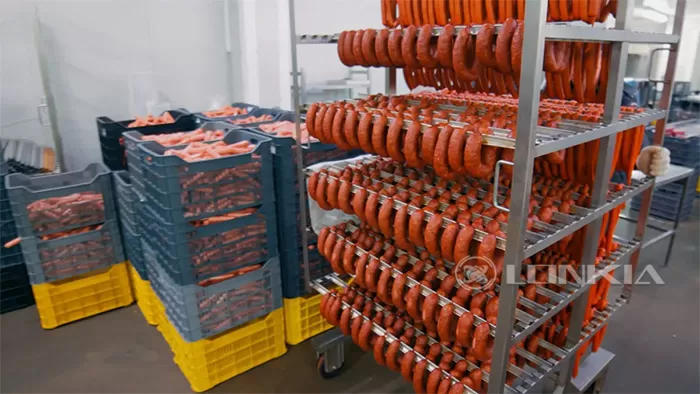Sausage manufacturing requires strict adherence to regulatory and safety standards to ensure product quality, hygiene, and consumer safety. Compliance with food safety laws is essential for avoiding contamination risks, product recalls, and legal penalties.
In this blog, we’ll explore the key regulatory and safety requirements in sausage production and provide practical strategies for meeting them effectively.
🔹 1. Understanding Food Safety Regulations
Sausage manufacturers must comply with global and regional food safety standards, including:
✔ HACCP (Hazard Analysis and Critical Control Points) – Ensures food safety by identifying and controlling hazards.
✔ USDA (United States Department of Agriculture) & FDA Regulations – Applicable to meat processing facilities in the U.S.
✔ EU Food Safety Regulations (EFSA) – Covers hygiene, labeling, and meat processing standards in Europe.
✔ ISO 22000 Certification – International standard for food safety management systems.
✔ Good Manufacturing Practices (GMP) – Ensures sanitary and safe food production processes.
✅ How to Stay Compliant:
🔹 Regularly review local and international food safety guidelines.
🔹 Work with certified auditors to ensure compliance.
🔹 Implement a documented food safety management system.

🔹 2. Hygiene and Sanitation in Sausage Production
✅ Why It’s Important:
Maintaining a clean and sanitary production environment prevents bacterial contamination and ensures food safety.
🔧 Best Practices:
✔ Strict Cleaning Protocols – Regularly sanitize grinders, mixers, stuffers, and conveyors.
✔ Personal Hygiene Compliance – Workers must wear protective clothing, gloves, and hairnets.
✔ Surface Disinfection – Clean all workstations with approved sanitizers.
✔ Waste Management – Properly dispose of meat scraps and by-products.
🏭 Key Equipment to Maintain:
✔ Meat grinders & mixers
✔ Sausage stuffers & fillers
✔ Cutting and slicing machines
✔ Packaging and sealing units
🔹 3. Temperature Control and Meat Handling
✅ Why It’s Important:
Improper temperature control can lead to bacterial growth, spoilage, and foodborne illnesses.
🔧 Critical Temperature Controls:
✔ Raw Meat Storage – Maintain at 0-4°C (32-39°F) to prevent spoilage.
✔ Cooking Process – Internal sausage temperature should reach at least 71°C (160°F).
✔ Blast Chilling – Rapid cooling prevents bacterial growth.
✔ Cold Chain Maintenance – Proper refrigeration during storage and transportation.
🏭 Recommended Equipment:
✔ Industrial refrigerators & freezers
✔ Steam cookers & smokehouses
✔ Temperature monitoring sensors
🔹 4. Preventing Cross-Contamination
✅ Why It’s Important:
Cross-contamination between raw meat, cooked sausages, and packaging materials can introduce harmful bacteria.
🔧 Prevention Methods:
✔ Separate Work Areas – Dedicated zones for raw and cooked products.
✔ Color-Coded Equipment – Use separate tools for different processing stages.
✔ Strict Handwashing Protocols – Employees must wash hands frequently.
🏭 Best Practices for Equipment Handling:
✔ Disinfect conveyors, hoppers, and cutting blades after each use.
✔ Store raw materials and finished sausages in separate storage areas.
🔹 5. Labeling and Traceability Compliance
✅ Why It’s Important:
Accurate labeling ensures consumer trust, regulatory compliance, and product recall efficiency.
🔧 Labeling Requirements:
✔ Ingredient List & Allergen Warnings – Clearly display all components.
✔ Production & Expiry Dates – Ensure traceability in case of recalls.
✔ Batch Numbering System – Helps track each production run.
🏭 Traceability Solutions:
✔ Digital tracking systems
✔ Barcoding and RFID tagging
✔ Automated record-keeping software
🔹 6. Worker Safety in Sausage Manufacturing Facilities
✅ Why It’s Important:
Ensuring a safe workplace reduces injuries and legal risks.
🔧 Safety Guidelines:
✔ Protective Gear – Employees must wear cut-resistant gloves, masks, and slip-resistant footwear.
✔ Machine Safety Protocols – Install emergency stop buttons on all processing machines.
✔ Ventilation & Air Quality Control – Reduces exposure to dust and smoke.
🏭 Recommended Safety Features:
✔ Non-slip flooring
✔ Proper lighting and warning signs
✔ First aid kits in all work areas
🔹 7. Regular Audits and Compliance Checks
✅ Why It’s Important:
Audits help identify potential hazards and ensure compliance with food safety regulations.
🔧 Audit Checklist:
✔ Sanitation Inspection Reports
✔ Equipment Maintenance Logs
✔ Employee Training Certifications
✔ Temperature Monitoring Records
✔ Schedule routine inspections to prevent violations and product recalls.
🔹 Conclusion: Ensuring Compliance for Safe Sausage Production
Meeting regulatory and safety standards in sausage manufacturing requires strict hygiene, temperature control, worker safety, and traceability protocols. By following best practices and investing in high-quality equipment, manufacturers can ensure safe, high-quality sausages while avoiding legal risks.
At LONKIA Machinery, we provide advanced sausage processing equipment designed to meet global food safety standards. Contact us today to find the best solutions for your hygienic and compliant sausage production line! 🚀
